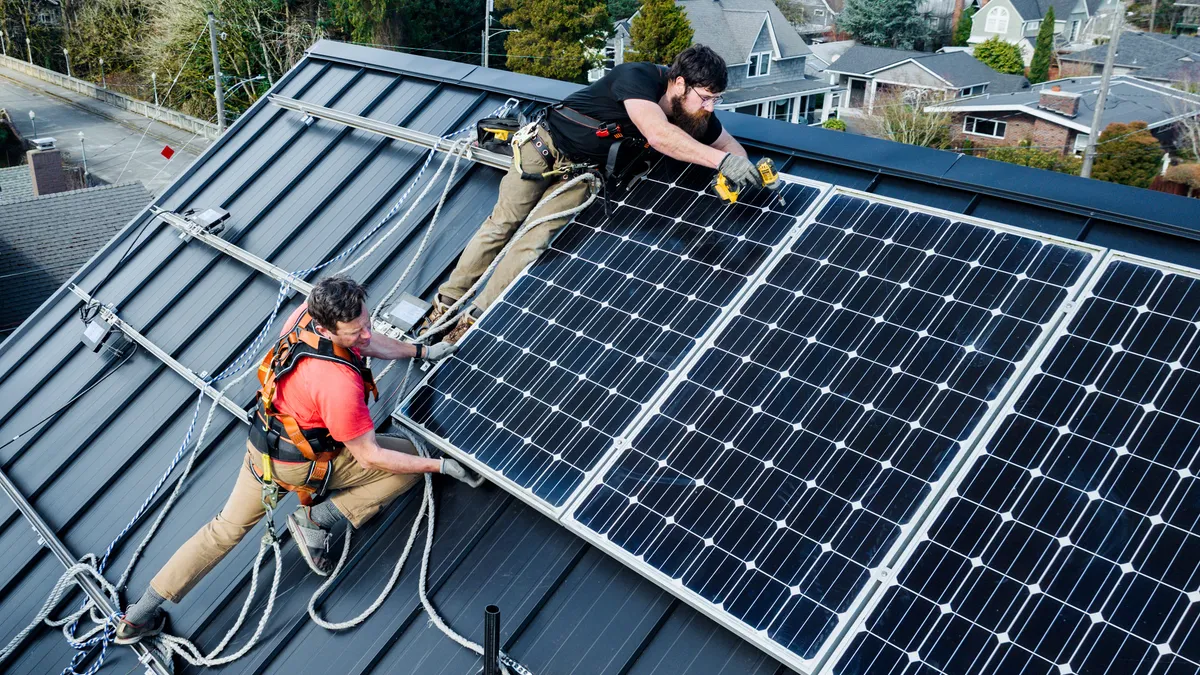Momentum continues to gather behind the emerging concept that offers solar for people who don’t have “the right roof or their own roof or a good enough credit score,” according to findings from new reports.
“Increasing the use of solar power” was among the top three energy-related issues for 64% of household decision makers in a 2015 Deloitte survey, up from 58% in 2014 and 50% in 2013.
Yet as many as three-fourths of all residential households may not be suitable for solar, according to a GTM report from last year. Increasingly, investor-owned utilities (IOUs), municipal utilities, and rural electric cooperatives are discovering they can fill that gap with community solar, according to Alternative Energy Leader Marlene Motyka, lead author of “Unlocking the value of community solar," a recent report from the Deloitte Center for Energy Solutions.
“Community solar allows utilities to offer solar to a customer base that is interested and wants solar and can’t get it on their own because they don’t have the right roof or their own roof or a good enough credit score,” Motyka said. “They might not have the rooftop option but they really want to be able to invest in and get electricity from solar.”
Financial consultant CohnReznick’s recent brief “Can Community Solar Bring Renewable Energy to the Masses?” confirms Motyka. Community solar’s market potential is “huge” because it provides “an alternative to rooftop solar,” it reports.
“Projects can be developed and owned by utilities or other third parties,” CohnRezneck adds. “Customers can either pay upfront for a portion of the project’s output or for a portion of a project’s capacity. Further, customers can either pay an entire amount up front or pay periodically, such as monthly.”
Market foundations
Since 2010, the market has grown from two projects to 111 at the beginning of 2016, comprising about 106 MW of capacity, according to Deloitte.
In the beginning, electric cooperatives and municipal utilities were some of the first to utilize community solar, the report notes.
The first U.S. community solar array was brought online in 2006 by the Ellensburg, Washington, municipal utility. Subscribers paid seven times their retail electricity rate for the 109 kW system, but they wanted solar.
Now, munis account for about 15% of community solar projects in the nation and about 31% of community solar capacity. Washington state is a leader in community solar thanks to a $0.30/kWh incentive for solar developed on public sites such as schools, parks and government buildings, the report notes.
Municipal utilities are leveraging state and local government incentives to add community solar, according to Deloitte, and co-ops have proved even more eager to enter the market.
Co-ops represent about 26% of electrical providers in the U.S. but administer 69% of community solar programs. Being smaller, less bureaucratic organizations, they reacted to the demand quicker than munis and IOUs, according to the report. Co-op projects tend to be smaller, around 350 kW, but they are growing, and the average size of planned projects is 747 kW.
And while they are slower-moving, IOUs are increasingly becoming interested in community solar programs because of the ability to answer customer demand for solar and potentially head off competition from residential solar and storage.
“For some homeowners, community solar may be a more compelling alternative to installing panels on their roof if it is offered by utilities,” CohnReznick noted in its report.
Currently, IOUs run 13% of community solar programs in the U.S. and 28% of projects. These trend toward larger-scale systems, accounting for 53% of installed community solar capacity. IOUs have developed pilots usually in response to state-level legislative directives, Motyka said, but they are becoming increasingly familiar with experienced private sector players.
Even so, these IOUs have to navigate through more complex regulatory schemes than their municipal and cooperative counterparts as they begin implementing new programs.
“The IOUs still have to make sure there aren’t regulatory restrictions,” Motyka said. “They will not try to do a lot of projects at once but will get into it and figure out how to properly advertise it and structure it so it is a benefit to their customers as well as their shareholders.”
Handling engineering studies and project applications before interconnecting big chunks of variable solar into their distribution systems adds more work for utilities, according to the report. Some regulatory environments allow cost recovery for the work, but many utilities haven’t yet figured out how community solar costs, benefits, and credits should be included on their customers’ bills
Utilities may be able to use community solar as a way to keep customers who want solar, but also want utilities to handle installation, maintenance and delivery of solar energy, according CohnReznick.
One business model is doing just that. In Tucson Electric Power’s community solar program, TEP handles the developing, operating, customer acquisition, billing and credit management. A special rate makes the solar-generated electricity slightly lower than retail, with the program now oversubscribed,according to CohnReznick.
Current market drivers
There is a wide range of factors attracting utilities, developers and customers to community solar, the Deloitte report notes.
For utilities, aside from meeting customer demand for solar, community solar allows utilities to leverage customer interest to market other products and services. An example is the Steele-Waseca Cooperative Electric (SWCE) program that gives community solar subscribers a discount if they also install a residential electric water heater. The solar is then used to heat water during the afternoon’s lower demand, which shaves the utility’s early evening peak.
Utility control of community solar development allows them to pick the project’s location, design, and orientation, which can optimize its value to the distribution system, Deloitte noted.
“Strategically placed shared solar arrays might help utilities defer or avoid the cost of upgrading transmission and distribution assets by reducing their use and prolonging their useful life,” the report reads.
Systems designed with tracking and oriented to the west can increase the installation’s peak period output, reducing the need to run costly fossil fuel peaking plants.
Finally, utilities can meet state mandates with community solar arrays while simultaneously obtaining these other benefits.
For customers, a key driver of interest in community solar participation is the falling price, Deloitte notes. The average price for a community solar subscription has dropped from $5.13/watt in 2010 to $2.92/watt in 2015 — a 43% decrease — Deloitte notes.
An IRS private letter ruling last year has supplemented the appeal of community solar by enabling community solar subscribers to claim the 30% federal investment tax credit typically given to rooftop and utility-scale solar owners.
For major solar developers, the opportunity to “unlock previously unreachable solar demand,” is a big attraction, Deloitte notes, while “small developers are beginning to offer niche, à la carte services that align with utilities’ needs.”
SunEdison’s partnership with National Grid in Massachusetts and SolarCity’s partnership with Sunrise Energy Ventures in Minnesota are examples of big developers seizing this opportunity.
Clean Energy Collective (CEC), the top U.S. private sector community solar developer, was one of the first to offer both project development services and utility system-compatible billing technologies. It now also offers its Community Solar Platform, a proprietary software-as-a-service (SaaS), to utilities and developers entering the market
Future growth opportunities
Community solar is expected to grow 59% annually through 2020, reaching a 2020 installed capacity of 534 MW, according to a recent GTM report.
These projections echo a similar takeaway from CohnReznick, which said “it is unlikely that more than 1 GW of community solar projects will be brought online this year or next. But in 2020, potentially, more than 4GW of community solar projects could be installed.”
CohnReznick added there is no reason why “tried and tested tax equity financing structures” can’t drive even greater community solar growth if investors “get comfortable with the different risk profile.”
The key difference, according to the brief, is that “instead of a single creditworthy utility off-taker taking physical delivery of the power, community projects have several if not hundreds of individual off-takers with varying credit ratings that do not take physical delivery of the power.”
Such a large number of off-takers leads to the potential for subscriber turnover and a revenue shortfall, the research firm wrote.
A common strategy for addressing this risk has been to oversubscribe community solar programs. “Subscribers on the waiting list can then instantly replace those leaving the program, ensuring the revenue stream is maintained,” the brief notes. Another strategy is to assume in financial planning that part of the revenue will not be collected.
The automated billing systems developed by CEC make the first option practical. If a customer defaults, the system replaces that account number with the account number of a customer on the waiting list.
“This de-risking means that, in many ways, financing community projects is lower risk than traditional rooftop solar,” CohnReznick reported.
The strategy is not a panacea, however.
“There are still questions about how quickly a system will develop a minimum subscriber base to make a particular project feasible,” said CohnReznick Partner Joel Cohn. Customer turnover, managing waiting lists, and replacing customers and their revenue streams with new customers “are not serious risks but they are different risks to the traditional solar financing model.”
The most important determinant of future growth will be enabling legislation that allows projects to sell power to “multiple off-takers — residents, municipalities, or businesses ... to receive monetary or electricity credits to offset their electricity bills,” CohnReznick reported.
Fourteen states and the District of Columbia (D.C.) have such policies — commonly called virtual net metering (VNM) —while other states are working on programs.
State programs & residential sector competition
While the CohnReznick report advocates for VNM, the Deloitte report warns that it is “not necessarily a market driver.”
Only 11 of the 111 active community solar projects are in states that have a “patchwork of VNM policies that vary by technology, utility type, and customer classification,” Deloitte reports.
State-level mandates may be more important, according to the consultancy. For example, Colorado, the state with the biggest installed community solar capacity, passed community solar legislation in 2010 and now has about 27 MW of shared solar across 37 projects.
Minnesota, with its aggressive VNM policy established in 2013, is expected to emerge in 2016 as the national shared solar leader.
In California, revenues from the state’s cap-and-trade program, required to be invested in renewable energy and energy efficiency programs, may drive community solar programs administered by municipal utilities.
And IOUs are on the verge of greater participation, though clarification of investment structures, interconnection standards, and rules around the role of regulated utilities in the private sector may be necessary, both papers reported.
There will not, however, be a head-to-head competition between community solar and rooftop solar, CohnReznick concluded, because they are not direct competitors. Rooftop solar is “not logistically possible for such a large number of households,” it reported. For households that do not have a rooftop option, the choice appears to be “community solar and no solar at all.”
For many households that have both options, though, community solar could be more appealing because it offers all the benefits of solar without a “rigid commitment,” CohnReznick explained. Community solar “enables individuals to decide how much capital they want to commit, and for how long, in a way that rooftop can’t.”
'Turning a challenge into an opportunity'
“The evolution of community solar is a classic case of business model innovation turning a challenge into an opportunity,” Deloitte reported, foreseeing “shared solar growth for years to come.”
Utilities that deploy the resource will reap the benefits that distributed resources provided to the grid and the benefits of customer engagement, Deloitte added. Program designs will vary by market and utility type, but when taken together, “they show how a highly regulated industry can leverage technology and policy to adapt to a changing business climate.”
The question is not “whether this market will grow but by how much,” according to CohnReznick, “and what will the impact be on incumbent players — notably the utilities and rooftop solar companies.”
Utilities will need to think about how projects are structured and whether to outsource customer acquisition and management, among other possibilities. But risks can be minimized and, if they design the program well, utilities will get distribution system benefits and customer engagement benefits.
“Community solar is beginning to flourish," said Conor McKenna, managing director of CohnReznick Capital Markets Securities. Community solar can net utilities much of revenue lost to rooftop solar as "the more forward thinking utilities understand that community solar is their opportunity to work with their customer base in a proactive and efficient way.”






















